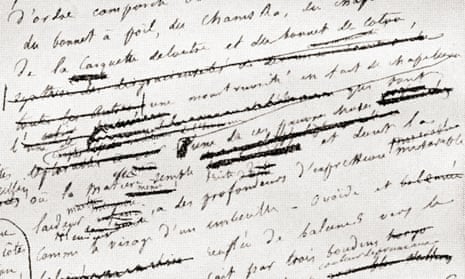Every writer, of school age and older, is in the sentences game. The sentence is our writing commons, the shared ground where all writers walk. A poet writes in sentences, and so does the unsung author who came up with “Items trapped in doors cause delays”. The sentence is the Ur-unit, the core material, the granular element that must be got right or nothing will be right. For James Baldwin, the only goal was “to write a sentence as clean as a bone”.
What can celebrated writers teach the rest of us about the art of writing a great sentence? A common piece of writing advice is to make your sentences plain, unadorned and invisible. George Orwell gave this piece of advice its epigram: “Good prose is like a windowpane.” A reader should notice the words no more than someone looking through glass notices the glass.
Except that you do notice the glass. Picture an English window in 1946, when Orwell wrote that sentence. It would be smeared with grime from smoke and coal dust and, since houses were damp and windows single-glazed, wont to mist and ice over. The glass might still be cracked from air-raid gunfire or bombs, or covered with shatterproof coating to protect people from flying shards. An odd metaphor to use, then, for clear writing.

Behind Orwell’s windowpane theory of prose lies a puritan pride, a sense that the writer will be purified by a clean, sinewy style as by an early morning run and a cold shower. “The great enemy of clear language is insincerity,” he wrote. Insincere writing spat out tired idioms “like a cuttlefish spurting out ink”. Bad ideas were the bedfellows of bad prose. Fake thoughts made fake sentences.
Some of this is true but none of it is a good way of learning how to write a sentence. More ethical demand than useful advice, it forces writers back to their own reserves of wisdom and authenticity. It blames bad writing on laziness and dishonesty, when a likelier culprit is lack of skill. If you ordered me to make a blancmange, all I could come up with would be a gloopy, inedible mess – not because I am lazy or dishonest, but because, although I have some vague idea that it needs sugar, cornflour and boiled milk, I don’t know how to make a blancmange.
Orwell saw the plain English sentence as the sword of existential truth, a cure-all for the bad faith of modern life. But much of the time he didn’t even follow his own advice. “If it is possible to cut a word out, always cut it out,” he ordered. Perhaps he should have written: “If you can cut a word, do.”
Orwell’s prose, as well as ignoring his own rules when it suits, is really a beautiful contrivance. Take the last thing he wrote, in his hospital notebook: “At 50, everyone has the face he deserves.” This unforgettable sentence has an argument behind it that a moment’s thought will reveal as unfair and untrue. Orwell’s oeuvre is full of such sentences that read like eternal verities and turn out to be nonsense. “We may find in the long run that tinned food is a deadlier weapon than the machine gun.” (We didn’t.) “Serious sport … is war minus the shooting.” (War minus the shooting isn’t war.) “Writing a book is a horrible, exhausting struggle, like a long bout of some painful illness.” (Steady on.)

A good sentence imposes a logic on the world’s weirdness. It gets its power from the tension between the ease of its phrasing and the shock of its thought slid cleanly into the mind. A sentence, as it proceeds, is a paring away of options. Each added word, because of the English language’s dependence on word order, reduces the writer’s alternatives and narrows the reader’s expectations. But even up to the last word the writer has choices and can throw in a curveball. A sentence can begin in one place and end in another galaxy, without breaking a single syntactic rule. The poet Wayne Koestenbaum calls it “organising lava”, this pleasure to be got from “pushing a sentence in a wrong direction without altering its sweet grammatical composure”.
A memorable sentence makes immediate sense but sounds just slightly odd. The model Kate Moss, once asked for her motto, replied: “Nothing tastes as good as skinny feels” – a terrible message to send about dieting and body image, but a well-turned sentence, surely. Skinny, usually an adjective, is here turned into an abstract noun, paired with another abstract noun, nothing. And yet skinny is also quasi-concrete, because where it lies in the sentence suggests that it can actually be felt, just as food has a taste. But feels also retains its non-sensuous sense of intuiting or experiencing something: skinny feels good. As the sentence ends with the snap of a stressed syllable, our perspective has been altered in a way that feels true, even if we don’t share the sentiment. Reality has shifted a little and then clicked back into place.
A sentence is much more than its literal meaning. It is a living line of words where logic and lyric meet – a piece of both sense and sound, albeit the sound is only heard in the reader’s head. Rookie sentence-writers are often too busy worrying about the something they are trying to say and don’t worry enough about how that something looks and sounds. They look straight past the words into the meaning that they have strong-armed into them. They fasten on content and forget about form – forgetting that content and form are the same thing, that what a sentence says is the same as how it says it.
The word “sentence” comes from the Latin sentire, to feel. A sentence must be felt by the reader, and a feeling is something that grows and fades like anything else that is alive. A line of words should unfold in space and time, not reveal itself all at once, for the simple reason that it cannot be read all at once.

John Donne’s sermons are full of sentences that are ever-alert and open to the world: “And into that gate they shall enter, and in that house they shall dwell, where there shall be no Cloud nor Sun, no darkness nor dazzling, but one equal light … ”. His sentences puzzle out their purposes in allusive phrases that hold the attention briefly before the next phrase takes to the floor. They flaunt their learning but revel in the loose-fitting ligatures of speech and thought. Donne’s prose, just like his poetry, is a sort of heartfelt thinking. It brings together judgment and gentleness, reason and passion, acerbity and receptivity. You can actually see him working it all out in front of you on the page, as each sentence moves and gathers force under the prickling itch of the moment – as if he is scrabbling his way towards a beautiful truth just beyond reach.
It’s all in the verbs. Virginia Woolf wrote that she wanted to go beyond the “formal railway line of sentence”, to show how people “feel or think or dream … all over the place”. Her serpentine sentences, held loosely together with dashes and commas, catch the butterfly restiveness of the human mind, and the evanescence of human life, as they come up against the more solid surfaces of the world. Like every skilled writer, though, Woolf starkly varies sentence length. Her long, elastic thought refrains collide with shorter, percussive fragments. A year into the second world war, she wrote this defiant sentence in her diary: “Thinking is my fighting.” Even if that doesn’t have what style guides tend to like – a concrete subject and a strong verb – it has a low rumble of energy running through it. Why? Because, apart from the possessive pronoun my, it consists wholly of verbs or verb forms.
A decade ago the American writer Gary Lutz gave a lecture to Columbia University students titled “The sentence is a lonely place”. Lutz told them that he was drawn to writing in which “the sentence is a complete, portable solitude, a minute immediacy of consummated language”. He wanted to read books that he could open at any page and find a sentence – “a totality, an omnitude, unto itself” – that gave him something illuminating and cherishable all on its own.
Contemporary writers mostly side with Lutz. They leave space and silence between their sentences, so that the reader can see the full stop and hear its click. Sentences have become less shackled to each other. Those written a few hundred years ago typically began with a whereof or a howsobeit, to resume an unfinished thought. And they used lots of conjunctive adverbs, those connecting words like moreover, namely and indeed. Such adverbs are in historical retreat. The use of indeed peaked in print in the 18th century and has been declining ever since. The number of howevers and moreovers has been falling since the 1840s.

Readers today can link sentences in their heads without lots of thuses and whereupons to do it for them. Just as cinemagoers have learned to see the implied continuity of time across the quick cuts of a film, without needing a caption that says “meanwhile, back at the ranch”, so have readers learned to make a little cognitive jump between sentences.
A lot of contemporary writing treats its sentences as lonely places, and then joins them together through evocative juxtaposition – the convergence of their collective solitude, if you like. This makes the sentences at the start and end of paragraphs crucial, because that is where the biggest thought-leap occurs. You can alter the whole tone of a sentence by moving it from the end of a paragraph to the start of a new one, and vice versa. Annie Dillard likes to start or end her paragraphs by swerving into unexpected terrain: “Why do we concern ourselves over which side of the membrane of soil our feet poke?” Maggie Nelson leaves gravid pauses between her sentences and paragraphs, where implications sit. Her book The Argonauts tells the story of a developing romance and relationship in short paragraphs and single sentences surrounded by white space. One paragraph begins with a sentence that sparingly conveys a new intimacy: “And then, just like that, I was folding your son’s laundry.”
If a writer’s sentences have enough life and interest in them – with “every step an arrival”, as Rainer Maria Rilke put it – they will hold the reader and move the writing along. The writing finds a hidden unity that has no need of the mucilage of linking phrases. Each sentence is like a tidal island that looks cut off until, at low tide, a causeway to the mainland appears. A good lesson for any writer: make each sentence worth reading, and something in it will lead the reader into the next one. Good writers write not just in sentences but with sentences. Get them right and everything else solves itself or ceases to matter

Comments (…)
Sign in or create your Guardian account to join the discussion